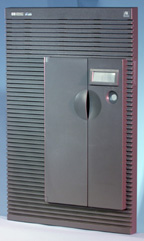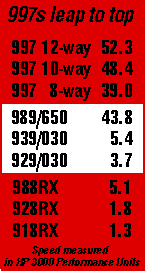 |
Click for BizNetTech.net Sponsor Message |
| February
2000
HP wires e onto its 3000 brand New e3000 name for platform signals positioning as Web engine Editorial: Outside dazzle, inside
changes Hewlett Packard’s 3000 division (CSY) renamed the HP 3000 as the HP e3000 this month, the first change in the product’s name in its 27-year history and evidence of a new mission for the system.
The
announcement “marks the evolution of the HP 3000 into a true
Internet platform,” said CSY General Manager Winston Prather.
“Like HP, the e3000 has been reinvented to meet the e-business
needs of today’s marketplace.”
“It’s not just because e and i are popular
letters now,” said Worldwide Marketing Manager Christine
Martino. “We think of e as meaning a lot more to us. It’s
enabling growth, both for the installed base customers and the new
customers we’re bringing. It’s for the enhanced application
partner and solution focus, and it’s for the idea of embracing
new technology: Web-enabling technology, key middleware
enablers.” “We’re really looking to create a new image for
the guy, with a new name and a new look,” Martino said.
“It’s a re-imaging to highlight how real customers are
solving real problems in Web-enabled environments and e-service
environments. We want an attention-getting way of helping people to
know that.” The technology attached to the rebranding covers a secure
Web server for the e3000, message-oriented middleware, Java 2, a
high-end server that’s 44-percent faster than its predecessor, a
Fibre Channel distancing solution, and new printer management
software for the division’s rebranded LineJet system
printers. HP
is wrapping the enhancements into its 6.5 release of MPE/iX, which
customers can order this month and which CSY promises to ship in
March. The release will be the first to bundle a Web server with the
fundamental operating system, along with the 1.2.2 version of
Java/iX, which Java creator Sun Microsystems calls Java 2.
Martino said that HP’s objective in renaming the system is “to really help people take notice of the 3000 again.” New print advertising including the new brand is being scheduled for what HP calls its “solution-based” publications, those focusing on vertical markets such as healthcare and e-commerce. The installed base will get a mailing of a special coupon book containing discounts from software partners related to the e3000’s launch. And HP came to its press briefing with new data on penetration in credit union and 911 dispatch industries which show the e3000 as a leader.
“We’re not making it a key player in the Internet
space, our customers and partners are doing it already,” Martino
said. “It’s all of the boring stuff behind the dot-com
stuff that’s necessary to have a viable solution.” HP
announced it will be shipping new 10- and 12-way e3000s as part of
the launch, putting the Series 997 servers back on top of the
performance charts. Measured against the previous 8-way top end of
the 997 line, the 12-way 997 is 44 percent faster by HP’s own
3000 Performance Unit benchmarks. But the 12-way 997 is a little less
than 20 percent faster than the previous speed champs of the e3000
world, the Series 989/650 6-way systems. HP is charging a premium for
this new speed of $160,000 over the current 8-way 997s, at a rate of
$40,000 per new processor. The 10-way system will be available for an
$80,000 upgrade over the 8-way price, a base unit price of $311,200.
The 12-way unit’s base price is $391,200, not including
peripherals or operating system. Field upgrades to the new systems
are available to current 997 customers.
Martino said that the new top end “is real important
for those folks who are pushing the limits of the system, like the
HBOC customers.” Customers must install the 6.5 version of
MPE/iX to use the 10-way and 12-way Series 997s. HP’s announcement introduced the idea of “street
pricing” of HP 3000s for the first time from Hewlett-Packard
officials, acknowledging that the reseller channel may offer hardware
at a price below the HP pricing. The first example of such street pricing came from the new
cost of the Series 918RX servers. HP announced a complete package
including database, storage and console priced at $13,459, 25 percent
below the current price for the RX models. HP is dropping the two-IO
slot 918LX and 928LX models to focus on just the 918, 928 and 988RX
models in its low-end line. An upgrade kit will continue to be
available to convert a 928 to a 988, almost tripling performance. A
988 still clocks in about 7 percent slower than the new model of the
Series 939 (see table at right). “Street price will be lower, depending on what a reseller will be prepared to do with a customer,” Snow said. Martino said the street price with volume purchases could be 25 percent below the suggested list price — which would put a functioning HP 3000 for eight users at just over $10,000.
The
$13,459 configuration includes 64Mb of memory, 9Gb of disk, a 4Gb
DDS-2 tape, 600VA UPS, and a console. This system has four IO
slots. HP
is introducing new 030 models of the Series 929s and 939s as part of
its rollout, replacing the systems’ PA-7200 processors with
next-generation PA-8000 processors. The newer 929/030 is about 12
percent faster than its predecessor and costs a little less, while
the 939/030 will be 17 percent faster than its 939/020 predecessor.
Suggested list price is $66,091 for a 929/030 unit with a 20-user
IMAGE and MPE/iX license, 128Mb of memory, a 9-Gb disk, 12Gb DDS-3
tape, UPS, and a console. Snow pointed out that when a customer puts MPE/iX 6.5 on
these new models in the e3000 midrange, the servers will support up
to 8Gb of memory. The new servers ship immediately and operate with
MPE/iX 5.5 and 6.0, as well as 6.5. HP
is shipping the latest version of its e3000 operating system as
“a high-end performance release and a scaling release,”
Martino said. “We sometimes call this the HBOC release, because
their customers really need this performance.” Tool partners and
application providers have been provided with the operating system to
make software tuning changes and compliance testing. The 6.5 release will also have an option to support a secure version of the Apache/iX Web server. This will be an item with a supplemental cost above the base license for MPE/iX, and customers will be able to order and take delivery of it in May. This version of MPE/iX also includes middleware of an LDAP
client and a JDBC driver, both of which have been available for the
6.0 and 5.5 versions of MPE/iX. It supports file sizes of up to
128Gb, and memory capacities larger than 3.75Gb. 6.5 will let
customers put on as many as 3,300 users. It also increases TCP
connections from 5,600 to 20,000, an improvement that Martino said is
vital for the businesses deploying their HP 3000s in Web
environments. Snow said the operating system has been re-tuned to better use multiple processors. Semaphores in the operating system used to dispatch processes and memory allocation were tuned, he explained.
“If you had a number of processors, you tended to queue
up on those semaphores, and that tends to slow the system down,”
Snow said. “We had to rewrite the memory manager and the
dispatcher to break these two bottlenecking semaphores up into
multiple semaphores. This let us achieve the performance we knew we
could achieve with larger multiprocessing.” While CSY was announcing its new e3000 brand, it pointed
to several emerging markets for the server. Quintessential School
Systems and SRN were noted as application partners in the education
market. Martino said that Wired magazine recently named Wake Forest
University as the most wired campus in the US, and SRN’s
Web-based 3000 solution is at the heart of the Wake Forest
operations. HP
is also renaming the LP Series of line printers as HP LineJets, to
demonstrate a closer link to the rest of HP’s printer families.
The LineJet units haven’t been changed, and continue to be
manufactured for HP by Printronix. HP is offering a new LineJet Print
Manager solution, software written in Java that lets managers control
LineJets from e3000, Unix or NT environments. It provides printer
status information remotely through a Web browser, including securing
printers against unauthorized intervention. The LineJet printer line is a part of the HP 3000
division, and has been since sometime in 1999, CSY officials said.
While development of the devices takes place at Printronix
facilities, CSY is responsible for marketing and positioning of the
products in HP server lines. Noting that Web applications require more distributed,
faster storage solutions, CSY officials announced the release of an
SCSI-Fibre Channel distancing solution and a new DLT8000 tape drive
for use with the HP 3000. While HP’s $9,000 DLT8000 is a tape
unit being offered by other vendors, the distancing solution is a
first: a $6,400 device that can place SCSI peripherals as far as 10
kilometers (6 miles) from an HP 3000. The device, manufactured by
Vicom Systems for HP, is available immediately. It is targeted to
operate with the SureStore Array Model 12H and XP256 storage
devices. HP is also announcing e3000 support for the Business Copy/XP and Continuous Access Manager/XP functions of the new SureStore E disk Array XP256 units. Support of this software previously required Windows NT systems; now it’s natively supported with MPE/iX. |
Copyright The 3000 NewsWire. All rights reserved.

 CSY had to get permission from HP corporate
branding committees to make the change in the product’s name, a
process which began in the division in late summer of 1999, about the
same time as HP’s corporate rebranding effort. But the CSY
executives say that adding a popular vowel to their product is more
than a bandwagon jump.
CSY had to get permission from HP corporate
branding committees to make the change in the product’s name, a
process which began in the division in late summer of 1999, about the
same time as HP’s corporate rebranding effort. But the CSY
executives say that adding a popular vowel to their product is more
than a bandwagon jump. Although CSY has rebranded the system, the
advances in the 6.5 release will operate with existing HP 3000s. HP
has created new hardware bezels for rack-mounted HP 3000s in a
slate-grey color (shown at right), “so you’ll be able to
look across a crowded computer room at a series of 9000s and 3000s
and clearly pick out which are the 3000s,” said Product Planning
Manager Dave Snow. It was Snow who brought the rebranding proposal to
the division last summer. All new systems will get new nameplates,
whether they are racked models or not.
Although CSY has rebranded the system, the
advances in the 6.5 release will operate with existing HP 3000s. HP
has created new hardware bezels for rack-mounted HP 3000s in a
slate-grey color (shown at right), “so you’ll be able to
look across a crowded computer room at a series of 9000s and 3000s
and clearly pick out which are the 3000s,” said Product Planning
Manager Dave Snow. It was Snow who brought the rebranding proposal to
the division last summer. All new systems will get new nameplates,
whether they are racked models or not. The horsepower will be most welcome in the
healthcare industry, according to HP’s own reports and those
from consultants. One consultant said the performance shortfall for
the largest healthcare shops today reminds him of the situation in
the 1980s, when customers were “trying to make do with Series
70s before the Spectrums came out.”
The horsepower will be most welcome in the
healthcare industry, according to HP’s own reports and those
from consultants. One consultant said the performance shortfall for
the largest healthcare shops today reminds him of the situation in
the 1980s, when customers were “trying to make do with Series
70s before the Spectrums came out.”